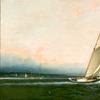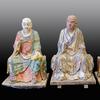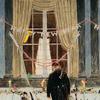Brothers Grin! £250,000 sale at Woolley & Wallis Smashes Expectations and Honors the Genius of the Tragic Martin Brothers
- SALISBURY, United Kingdom
- /
- November 28, 2019
U.K. auctioneers sell out leading collections in landmark sale of exceptional vases, jars and figures by amazing Victorian potters
Two outstanding collections of rare British Victorian pottery have sold for £250,000 at Salisbury auctioneers Woolley & Wallis, smashing pre-sale hopes of £160,000.
The top two selling pieces alone took well over £50,000 between them – a rare Wally bird tobacco jar and an ultra-rare Bird man jar.
For Woolley & Wallis Head of Design Michael Jeffery, this was a personal as well as professional triumph, as he pioneered UK sales of Martin Ware, starting in 2005.
But today’s result is also a poignant reminder of four brothers who gave their lives to creating the haunting and humorous grotesques and gurning face jugs, while never benefiting themselves from the eventual success of their inspired genius.
“If only the four Martin brothers were here today to see this,” said Michael. “They were geniuses, really, with many of their designs decades ahead of their time and anticipating modern art, but only one of them lived to see their creations meet any sort of financial success.”
It all started in the family home in 1873, when the four Martin brothers – Robert Wallace, Walter, Edwin and Charles – fired up their first kiln. Moving to a disused soap works in Southall, west of London, four years later, their 50-year production would come to an end in 1921, when only Robert Wallace, the eldest, was still alive to see bidding at Sotheby’s in London reach £50 for a single bird jar.
It was a poignant moment for a man whose family had only ever known poverty as they struggled to fulfil their artistic dreams – “my brothers and myself never got more than a labourer’s wages”, he said in 1910 – with Robert Wallace modelling the figures, Walter overseeing the kiln, mixing glazes and throwing pots, Edwin decorating the output and Charles managing the shop from where they attempted to sell their wares.
Artistic geniuses they may have been, but when it came to the commercial side of the business they were a uniform disaster, starting with Charles, who hid his favourite pieces under the floorboards of the shop because he could not bear to part with them and turned away potential customers. Eventually, the shop burned down, taking the stock and Charles’s remaining semblance of sanity with it. He died in an asylum in 1909, a mere six years after their sister had succumbed to a monkey bite.
The other brothers were little better when it came to the money side. They could only afford to fire the kiln once or twice a year and because they had no money to pay for the protective containers required to hold the pots during firing, many emerged damaged beyond saving after their direct contact with the flames.
Two years after Charles’s death, Edwin started to show signs of the facial cancer that would kill him in 1915; shortly after that Walter knocked his elbow while packing the kiln in 1911. The resulting wound and blood clot caused a fatal cerebral haemorrhage just three months later.
Tragic though their fates may have been, the brothers’ reputation grew quickly, with royalty and leading artistic lights of the day, such as the Pre-Raphaelite painters Edward Burne-Jones and Dante Gabriel Rosetti, becoming avid collectors. In 1914, Queen Mary ordered 60 pieces of Martin Ware to be exhibited at the Paris Exposition.
It was in 1978 that London dealer Richard Dennis staged the landmark exhibition, The Martin Brothers Potters, at Sotheby’s Belgravia, complete with a specialist sale that effectively created a new market for Martin Ware. With Malcolm Haslam, Dennis also co-authored the standard work on this field of pottery, entitled The Martin Brothers Potters.
“What was especially interesting about today’s sale was how string prices proved for a lot of the lower end vases,” said Michael. “In some cases, where we might have expected a couple of hundred pounds, bidding soared into the thousands. I think that’s a reflection of the fact that more people are waking up to what an amazing range this is and how broad the brothers’ talents were, as illustrated by these two amazing collections.”

270x400_c.jpg)







_-Closing-the-Distance_100x100_c.jpg)







